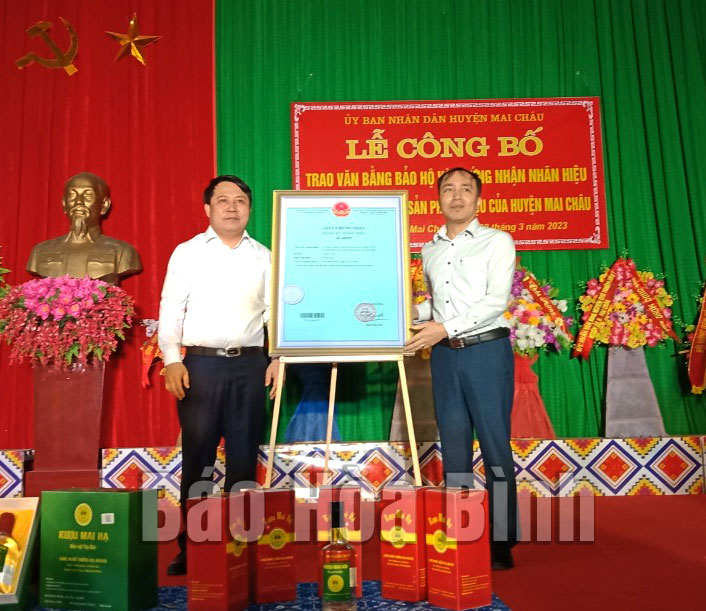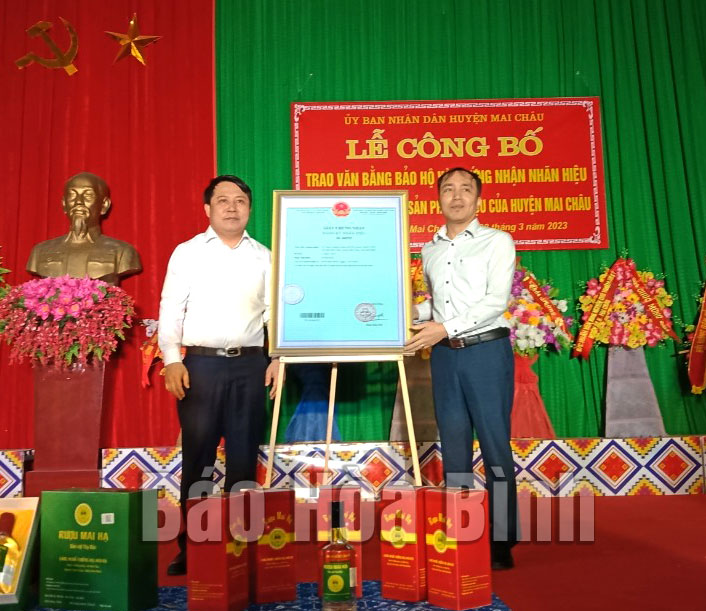
(HBO) – A ceremony was held at Mai Ha commune of Mai Chau district on March 28 to announce and hand over the trademark protection certificate to "Mai Ha wine” product of the district.
A leader of the Mai Chau district People’s Committee hands over Mai Ha wine trademark protection certificate to a representative of the People’s Committee of Mai Ha commune.
Mai Ha wine is exclusively produced in Mai Ha commune. The most special feature of Mai Ha wine is that the yeast is made by locals’ own method with many stages. Many kinds of precious ingredients and herbs are produced locally following the secrets of families passed on to their descendants to create a unique flavour that is not found in any wine made in other places.
Mai Ha wine product has been granted intellectual property protection certificate by the National Office of Intellectual Property.
The People’s Committee of Mai Chau has built a set of criteria for identifying distinctive quality of the product, along with trademark design, a set of regulations on management and development of Mai Ha wine trademark, and plans and strategies to promote and sell the product through distribution channels with identification and traceability system, in order to establish a mechanism to protect, manage and use the "Mai Ha wine” trademark, thus ensuring the quality control and trade promotion for the product.
Statistics showed that currently, 45 local households in Mai Ha engage in wine production, mostly in Chieng craft village where 30 producers are residing. Each month, the households produce nearly 2,000 litres of wine to sell in Hanoi and some neighbouring provinces. Notably, Mai Ha wine produced by some facilities has been recognised as a three-star OCOP (One Commune-One Produce) product.
At the ceremony, a representative from the Mai Chau People’s Committee handed over the Mai Ha wine trademark protection certificate to the People’s Committee of Mai Ha commune, and the trademark certificates to 30 wine production facilities in Chieng Ha village./.
In Lac Thuy district, communes have been succeeded in promoting their One Commune-One Product (OCOP) products while others are still struggling to position their typical farming products in market. Some communes in the district still fail to have their products met OCOP programme’s requirements, while others have seen their certifications expired.
The inspectorate agency of Hoa Binh province has issued Official Dispatch No. 1090/TTr-PCTN to provincial departments, agencies, localities, business associations, enterprises, and investors regarding measures to improve informal component indexes of the Provincial Competitiveness Index (PCI).
Hoa Binh is taking concrete steps to improve its investment environment, with a strong focus on supporting businesses, settling obstacles for strategic investors, and creating opportunities for robust development in the coming years.
Under the blazing early summer sun, the construction site of Nhuan Trach Industrial Park (IP) in Luong Son district is abuzz with activities from dawn to dusk, a testament to the determination of the investor to meet their construction targets on schedule.



